Monogram’s outstanding 1/72nd scale B-36
1: The Aircraft:
During the period prior to the U.S. entering the war, in 1941, a watchful eye was kept on England as Germany underwent the “blitz”. Knowing that if England fell, there would be no bases available to launch bomber aircraft against targets in Germany. As the U.S. Army Air Corps (USAAC)was woefully under prepared with aircraft with global mission capabilities. in April of 1941, the USAAC issued a request for an aircraft with intercontinental capabilities with specifications for speed, ceiling etc. These requirements proved too demanding for any short-term design—far exceeding the technology of the day—[5] so on 19 August 1941, they were reduced to a maximum range of 10,000 mi (16,000 km), an effective combat radius of 4,000 mi (6,400 km) with a 10,000 lb (4,500 kg) bombload, a cruising speed between 240 and 300 mph (390 and 480 km/h), and a service ceiling of 40,000 ft (12,000 m),[4] above the maximum effective altitude of all of Nazi Germany's antiaircraft flak guns, save for the rarely deployed 12.8 cm FlaK 40 heavy flak cannon. [Wikipedia.]
As the war in the Pacific continued it became clear the US Army Air Force (USAAF) needed a long range bomber to operate out of bases in Hawaii, capable of striking targets in the Pacific Theater of Operations (PTO) and Japan itself. Due to this need the development of the B-36 began in earnest. The USAAF initial request was for 100 bombers before the completion and testing of the two prototypes. However Convair, as it was known after it's merger in 1943 with Vultee, delayed production due to the production of the B-24 Liberator and later the B-32 Dominator, so it wasn't until 20 August 1945 that the aircraft was unveiled and flew for the first time, almost a year later on 8 August 1946.
After the establishment of an independent United States Air Force in 1947, the beginning in earnest of the Cold War with the 1948 Berlin Airlift, and the 1949 atmospheric test of the first Soviet atomic bomb, American military planners sought bombers capable of delivering the very large and heavy first-generation atomic bombs.[Wikipedia]
The B-36 was the only American aircraft with the range and payload to carry such bombs from airfields on American soil to targets in the USSR. The modification to allow the use of larger atomic weapons on the B-36 was called the "Grand Slam Installation”.
On 12 February 1959, the last B-36J built, AF Ser. No. 52-2827, left Biggs AFB, Texas, where it had been on duty with the 95th Heavy Bombardment Wing, and was flown to Amon Carter Field in Fort Worth, where it was put on display. Within two years, all B-36s, except five used for museum display, had been scrapped at Davis–Monthan AFB.
The B-36 was the largest Piston driven aircraft ever built. With a wingspan of 230' it was longer than the C-5 galaxy. It had a wing chord of 7' 6” to allow crew to service engines and landing gear whilst in flight, This large wing area allowed it fly at over 40,000 ft. It was 162' long, 2/3rds longer than the then super bomber the B-29. It had a range of almost 10,000 miles and had a top speed of 435 mph. At altitude no enemy fighter of the day could engage it effectively.
2: The Model:
Monogram dropped a real bombshell on the modeling world in 1980 with the release of their 1/72nd B-36 Kit #5703.. It was marketed as the Largest Plastic Scale Aircraft Model kit, surpassing the record held by Monogram's B-52 which had sole claim to that title up to that time. Prior to Monogram releasing the B-36, the only other injection molded kits were the Revell 1/184 kit with no landing gear, which hadn't been re-issued for some time, and the Aurora boxing about the same scale but with landing gear. Contrail released a 1/72nd Vacuform kit, of which I only ever saw one built. Upon hearing that the local hobby shop had these in stock, I rushed down and bought and excitedly built one.. The model is quite large. The fuselage is 27 ¾ inches long, wing span is 38 ¼ “ and the tip of the tail rises to dizzying height 7 ¾ “. Naturally it's size makes it unwieldly to work with, and it requires a lot of shelf space.
I managed to score a 1980 release off the Scale Model Graveyard for a decent price as two propeller blades had broken of their hubs; an easy fix as the break was clean and easy to repair. I started the kit per instructions. It takes a lot of nose weight that I superglued into the void behind the radio room bulkhead. There was a slight warp in the fuselage that I tried to work by fixing small areas of the fuselage at a time until the entire fuselage was buttoned up. I even used some brass tubes to replace a couple of broken locator pins. This worked fine for the main part but required a fair amount of sanding and filling. The wings went together well, no fit issues, just some sanding to eliminate the seam on the leading edge and sanding around the engine nacelles.. Monogram could have saved the modeler a lot of sanding time had they molded the nacelle rings where the props fit into as a separate ring. Minimal sanding took care of the seam none the less.
Painting was a bit of a challenge as to color, shades etc., and the amount of tape it takes. I used an entire roll plus of Tamiya tape. I was modeling the Photo/Reconnaissance version which used part of the bomb bay as a crew station, so being pressurized the magnesium portions were a little different. Painting Natural Metal Finishes is always a challenge and this was no exception. I used Testors Aerosol Silver Metallic for the overall base paint. I left the wings off for ease of masking, handling and painting the fuselage and wings. I used Testors Model Master Anodonic Grey for the Magnesium areas, Alclad Dark Aluminum for the wing walk areas, Alclad Duralum for the control surfaces and Alclad White aluminum for the trim tabs. Naturally, when I pulled the tape off there were tape marks in the paint, but these were corrected with some vigorous rubbing with a tissue and a micro fiber cloth. For sealing the decals and paint I brushed on Pledges/Future acrylic floor finish. Markings are from Warbird sheet #72-002 for the aircraft marking and 72-003 for the stenciling and and wing walk lines. Canopy masks are from "New Ware" from the Czek republic. The model represents an RB-36E from the 5th SRW, 72nd BS, 15th Air Force, stationed at Travis AFB in 1952.
Large models like the B-36 and others offer unique challenges to the modeler, not ordinarily encountered in smaller kits. Just trying to figure out how to paint it and decal it. How to handle it without busting something off, where to build it and finally where to put it? All require planning a fore thought. I would highly recommend it; if you have the room. Not a contest winner, but I like it and will enter it in the display category.
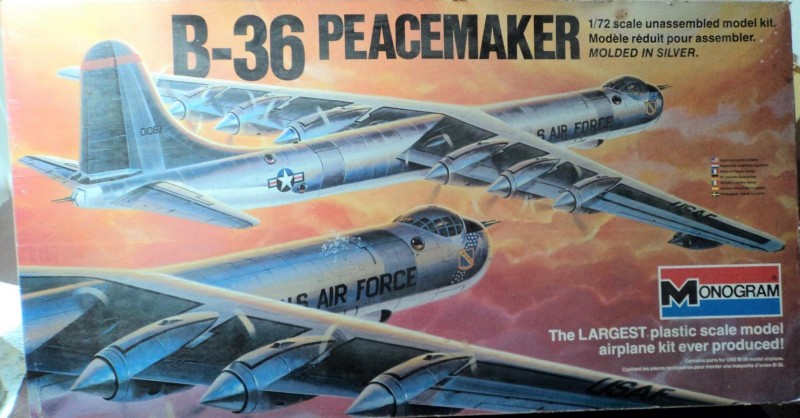
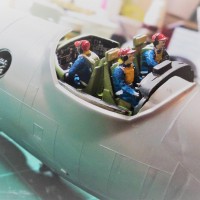
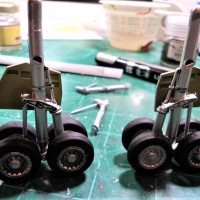
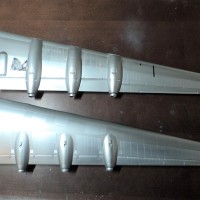
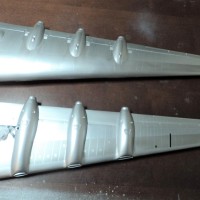
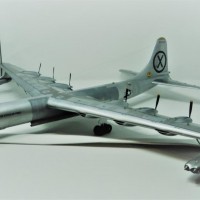
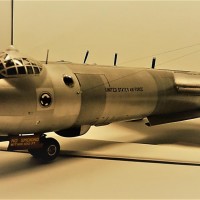
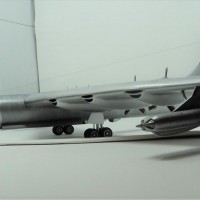
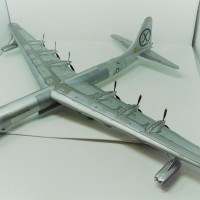
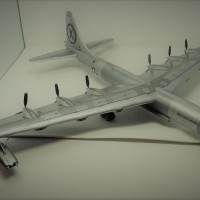
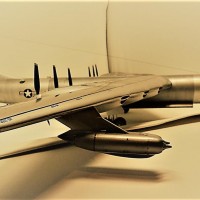
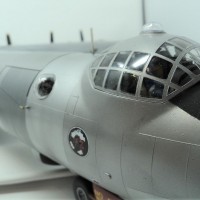
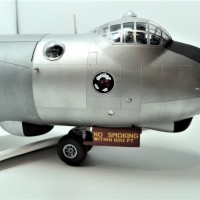
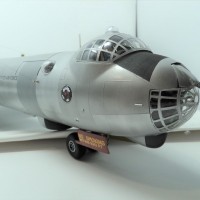
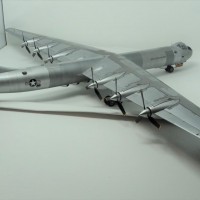
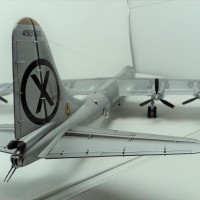

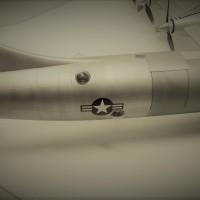
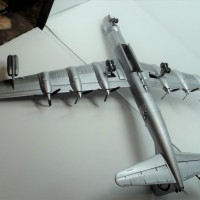
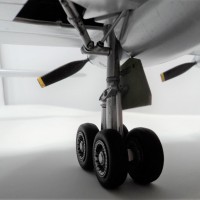
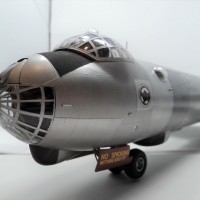
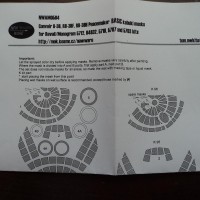
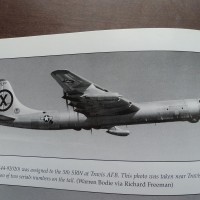
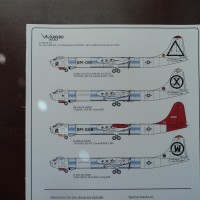
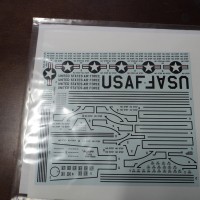
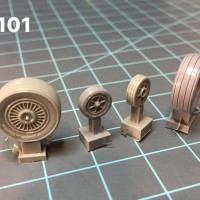
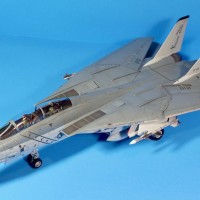
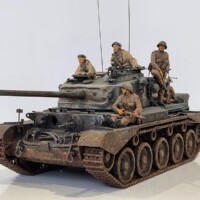

Fantastic job, Mark. I built the same bird as "1092' a dozen years ago and I loved it. I didn't do the quality shading job you did, just aluminum all over, so I'm a bit embarrased to post pics...we will see.
Excellent work; thanks for sharing!
All the best!
Thank you Spiros: Post your pictures. IT's nice to share and see what other people are doing, that's how we learn.
Congratulations Mark an epic project! Great build!
How much metalizer paint did you end up using?
Hello David, thanks for looking in. I used a lot, but with my new air brush (I won at the Club white elephant "party") I have to thin the paint quite a bit, so it goes a long way. Not as much as I thought. Albleit I did use a lot of the initial painting with Testors Metallic Silver out of the Aerosol. It lays on real nice and when set, doesn't do the tape pull. The rest through the air brush, not as bad as I figured.
Acres of classic Monogram plastic and litres of paint plus modelling skill equals a really great model. Well done.
Thank you Haslam: Yes lots of plastic and paint and decals. It turned out pretty darned good. Thanks for looking in and your kind comments.
In case you missed it, Jimmy Stewart flies a B-36 in the 1955 movie 'Strategic Air Command'. So if you want to see some fantastic and rare footage of this bird in flight. Heck, just watch the flying bits of the movie on the YouTube. How did this thing ever get off the ground. Anyway, yours looks terrific. Thanks for the effort and thanks for posting.
Thanks for looking in and your comments: I have a lot of B-36 videos and of course "Strategic Air Command" one of my all time favorites. It certainly had an interesting career and history making it a significant aircraft. Paramount did an excellent job of filming the B-36, on the ground, the tour of the airplane throught the "Holland Tunnel", in flight and inside. Great movie with a great cast. Lots of motivation to continue the build when I got bogged down.
Mark my hats off to you for even attempting to build this monster. As you've mention just trying to figure out how to build and paint this model is a daunting task. You executed it very well IMHO. I've seen the 1:1 scale B-36 at the USAF Museum in Dayton and to say it's big is an understatement. Nicely done Mark, so where do you intend to display it?
Thanks for looking in and your comment. A lot of motivation went into this one. Living an hour and a half from Tucson, before the "Crisis" my buddy and I drove to the PIma museum and saw the one they have there. IT's something to see it in person, as you know. Sadly, it sits outside and is showing the signs of weathering. Too bad the museum can't put a "car port" type structure around it to keep it from weathering. I have a spot for it in the computer room, so it will be on display. I need to get a case for it.
Really great work with this excellent result in this project. It is a great inspiration for all of us modelers.
Thank you Roberto for looking and your kind words. Duly appreciated.
Excellent build, Mark...the B-36 is one huge kit. I built this kit when it first came out, and one was enough for me.
Your pix show one of the many interesting aspects of the B-36: the fact that the flight engineers sit up in the flight deck, but facing backwards, so that they can observe the engines. I am fortunate to live in central California, where we have an RB-36H located nearby, at the Castle Air Museum, Atwater CA. This particular B-36 was trucked to Castle from Chanute AFB (?); it was trucked in large pieces, then reassembled on site. Castle has "open cockpit days" twice a year (due to these strange times, I'm not sure if the open cockpit days at Castle will be held this year), when you can climb into the B-36 and see the flight deck, with the backwards flight engineer seats. The view from B-36 canopy is pretty spectacular, for sure.
Thank you Marvin for checking out the build and your comment. I have watched the video about the B-36 at Castle. It's quite the story and speaks of the dedication of the volunteers that brought it from Illinois to Castle. My former spouses dad served with SAC as a Boom Operator and was stationed there at Castle. I would like to see it and go through it during open cockpit days. I live in Arizona so the drive wouldn't be impossible, but now during this "Crisis" I am sure everything is closed. I am about an hour and a half from Tucson and have finally seen the B-36 there. Quite impressive is an understatement. The B-36 at Pima had to be trucked from Ft. Worth after the crew that restored it there had no place to put it. Sadly, it is showing signs of weathering. I think the B-29 Flight engineer faced aft as well. Neat stuff. Thanks for your comments and checking in.
Gooooooooo Monogram! As the self proclaimed cheerleader and promoter of all things Monogram I approve of this model! Seriously, very nicely done. I built this kit years ago, died the death of my joining the Navy. Mine was not nearly as nice though!
Hi Rob: Thanks for your approval, duly appreciated. ;). You should tackle this kit again. It was a very enjoyable build for me. As mentioned in the blog, I took my time, spent a little time on it each night, had a plan and space for it and there it is. It's not perfect but what model is. I like it and the comments are nice to receive.
I too am a big fan of Monogram kits. Even back in the days when folks in the club were bashing Monogram for raised panel lines etc., I always preferred them over anything else, unless of course Monogram didn't make it. I am now looking for a B-29, at a decent price, to add to the collection I have of the "Big Bombers". Thank you for looking in and leaving your nice comments. Duly appreciated.
I may have to try one. The B-29 can be found for decent prices, I was able to get an original 1977 release for I think...$75? The diorama sheet was in it and everything, decals are shot, but that's to be expected. The moldings are sooo clean and flash free! They are out there.
That’s really well done, Mark. I built that in ‘80 or ‘81, painted with Testor rattle can silver and white. I remember spending days masking and brush painting the wing walks with Humbrol black. Sadly, that one never survived.
Thank you John: When I built mine in 1980, totally airbrushed and cut out all the canopy framing. I ended up giving to a neighbor kid when I moved away. He eventually went in the USAF. I had to do another one. I am happy with the results. Thanks for scoping it out.
what fine work on such a cool model
Thank you Bob for checking it out and your thoughts on the model, duly appreciated.
It's all been said here, Fantastic build! I thought that the pilot did resemble Jimmy Stewart.
Hello Robert: Thank you so much for checking out the build and your comment. I have always been a fan of Jimmy Stewart. Any resemblance is purely coincidental.
Something like 12 or so missions in a B-17 ?
If you mean Jimmy Stewart, he had twenty or so in B-24's..
Great looking model of an elegant plane. They had B-36's at an Air Force Base near where I grew up and I remember seeing one in an air show when I was a kid. Still remember the size!
Bravo! A kit which is in many stashes but one which is rarely seen built!
Thank you for that Jeff. I suspect you are correct, many in the stash to be built.
Always glad to someone build the nearly un-buildable (due to its size.)
Hope you have a good place to park that beast.
Thanks Dan: I do have some real estate to park it. It's next to my computer stand so I can see it.
Great looking build, although I wouldn't call the Monogram B-36 an "outstanding" kit. There's a lot wrong with it. The biggest problem being the wings. There shouldn't be a hump in the middle of the fuselage. To correct it is a monumental task. Quite honestly, not worth doing because of all the collateral mods you have to accomplish. Also, the kit doesn't truly represent a B-36 type that was ever built. It's more of a hybrid of two B-36 models.
Hello Steve and thanks for looking in and your comment.
It's the best B-36 in this scale...seeing as the only other option is an old vacuform kit.
I think the best representation of the Peacemaker is the gigantic...or titanic...or just flat out BIG, 1/48 scale kit. They did a better job in representing the B-36 than Monogram did. I'd love to have one, but I think I would need to rent hangar space at the local municipal airport to display it.
There is a modeler on Imodeler that started one of those. Lots of cutting. The modeler has to cut the cockpit area, the blister positions, the bomb bay's. The thing is huge. The 1/72nd kit is unwieldly enough, I couldn't imagine trying to work on one in 1/48. I have never seen one finished. I have seen the test shots but never a finished model. I think they go for about $1k.
Very nice! Though that's my chosen scale, I'll never take this baby on - just too big to store anywhere!
Thanks Greg for looking in and your comment, it's too bad that the 1/144 scale kit by Hobby Craft isn't available. I would think 1/100 would be an ideal scale for this airplane. A nice companion to the Tamiya 1/100 B-52.
Excellent job on a massive and challenging kit. Well done. Built the Monogram B-52 back in the day but never tackled this one.
Thanks for your comment Christopher. It is challenging but worth it in the end. I have the Monogram B-52 and the NB-52. Don't know when I will be getting around to them but "one of these days".
I wish I had the room for one of these. I have the Roden 1/144 in my stash, nearing the day it will be started. It is a bit sobering that the 1/144 kit is larger than the 1/72 B-24...
Thanks you Marcello for looking in and leaving your comment. Much appreciated. IT was a very large aircraft and the 1/72nd kit next to the Monogram B-29 is larger than the B-29 in 1/48 scale.
Very nice, sir! My grandfather flew the Peacemaker out of Carswell AFB in Texas (shown in Jimmy Stewart’s movie) for SAC before moving to missiles. I’d like to build a -36 model as a tribute to him (and my dad and I built many a model when I was younger). Is Monogram’s kit still the best overall, despite its flaws, or are there other choices now? I’m fine scaling down, esp. if the kit is from a company like Tamiya.
Best to you.
Thank you Andrew for posting your comments. The Monogram kit can be found on eBay and other plastic auction sites and the prices reflect that. The kit is sometimes in production by Revell of Germany for a nice price tag. It's a huge model when finished and very awkward to paint. Roden makes a very nice kit of it in 1/144 scae which is more manageable, and Atlantis has released the old Revell 1/184 scale kit of it as well, however that kit needs a lot of TLC to make it look halfways decent. I chose the Monogram kit as it brought back memories and in my opinion it captures the scale and size of the airplane. If you have a lots of room, I would go for it. I am not sure what the "Problem" is with the kit, but if that's what you want go for it. I haven't build the Roden kit, so I can't comment on that. I did build the Revell/Atlantis kit, needs a lot of TLC, but in the end it's a neat little model of the B-36 and looks good on the stand. Best wishes on your quest, a fitting tribute to your Grandfather. I'd be interested to know what you decide.